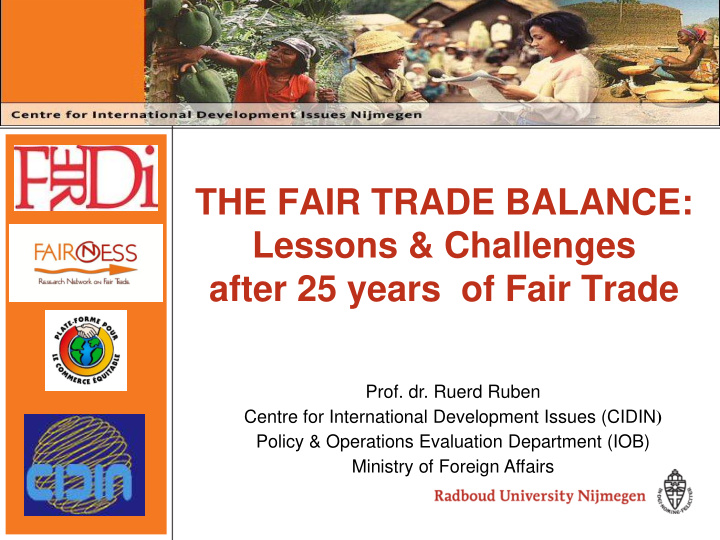



THE FAIR TRADE BALANCE: Lessons & Challenges after 25 years of Fair Trade Prof. dr. Ruerd Ruben Centre for International Development Issues (CIDIN ) Policy & Operations Evaluation Department (IOB) Ministry of Foreign Affairs
The Development Impact of Fair Trade Fair Trade • 1988: Introduction Max Havelaar coffee - Minimum price guarantee (set by FLO) - Pre-finance & Fairtrade Premium - Environmental + Labour conditions - Market share: 2-3 % • 1996 : Fair trade fruit (bananas,mango, citrus) - Turnover Euro 80 mln (2008) - Annual growth 40%, Net profit 1.5% - Market share: 5-15 % • 2012 : € 3,5 billion - 700 organizations - 1.500.000 families
The Development Impact of Fair Trade Proliferation of Labels
The Development Impact of Fair Trade Diversification of deliveries
The Development Impact of Fair Trade Impact assessment • Un-biased impact measurement (with counterfactual) • Control for self-selection & unobserved heterogeneity • Micro + Regional analysis • Plot, household & village level • Life cycle effects • Cross-country comparison • Smallholders & plantation production
The Development Impact of Fair Trade Study design • Focus on 2 commodities: coffee & bananas • 5 countries: Peru, Costa Rica, Kenya, Uganda, Ghana • 1000 farm households: 500 FT & 500 non-FT farmers • Conventional & organic production • Old & younger farmers • Different standards (‘fair’, ‘responsible’, ‘sustainable’) • Approach: Propensity score matching (PSM) & Difference in Difference Analysis (DiD)
The Development Impact of Fair Trade Impact Assessment • Impact assessment at producers’ level - Direct Income & welfare effects - Expenditure effects - Organizational impact - Gender & Environment • Externalities & Spillovers: - Other household activities - Regional level (prices, wages, FT premium) - Risk attitudes & behaviour
The Development Impact of Fair Trade Matching: nearest neighbour After Matching Before Matching 2.5 2 2 1.5 1.5 1 1 .5 .5 0 0 0 .2 .4 .6 .8 1 0 .2 .4 .6 .8 Propensity Score Propensity Score Control Control Treated Treated Number of observations on Common Support • • ON-CS OFF-CS Total FT 42 6 48 Organic 97 6 103 FT 39 9 48 Conventional 30 6 36
Measuring Impact of Development Programs Difference – in Difference Method (DiD) Intervention Control group Difference across group groups I 0 – C 0 Baseline I 0 C o I 1 – C 1 I 1 C 1 Follow-up I 1 – I 0 C 1 – C 0 (I 1 – C 1 ) – (I 0 – C 0 ) = Difference (I 1 – I 0 ) – (C 1 – C 0 ) across time Change in performance before / after the program between target and control group
The Development Impact of Fair Trade Results (1) Indicator FT non-FT sign Household Net Income + - n.s Crop Yield + - * Crop Price + +/- ** Other household income - + * Expenditures to Education ++ - ** Expenditures to Housing + - * Asset ownership + - ** Credit access ++ - ** Input use + 0 * Soil quality investments 0 0 n.s
The Development Impact of Fair Trade Results (2) Indicator FT non-FT sign Organizational force ++ - ** Cooperative service provision + - n.s Cooperative identification + - *** Female participation - + * Gender empowerment - + n.s Sustainability + - n.s Risk acceptance ++ - **
De Impact van Fair Trade Smallholders & plantation workers 6000 180 160 5000 140 4000 120 100 US$ US$ 3000 80 60 2000 40 1000 20 0 0 Salary Fringe Premium Own Plot Salary Fringe Own Plot FT Organic Non-FT-Organic FT-Conventional Non-FT-Conventional Benefits Benefits Organic Conventional Fair Trade Non FT Peru: Coffee Farmers Ghana: banana workers
The Development Impact of Fair Trade Fair Trade Premium • Investments in community services • Social services: education, health care • Physical infrastructure: roads, electricity, water • Upgrading: microfinance, crop renovation, insurance
The Development Impact of Fair Trade Externalities (Peru) 70 60 Regional prices 50 40 FT market share 30 20 10 0 1997 1998 1999 2000 2001 2002 2003 2004 2005 2006 2007
The Development Impact of Fair Trade Fair Trade & Private Standards Organizational Fixed Cooperative Support minimum price Technical x x x x x x x x x Variable Cooperative Support x x x x x x x x x Market price
The Development Impact of Fair Trade Comparison of Standards (Nicaragua) 25,00 20,00 15,00 Coffee Price ($) Coffee Yield 10,00 5,00 0,00 FT Conventional Independent Farmers FT Organic Rainforest Alliance Fair Trade Café Practices
The Development Impact of Fair Trade Comparison of Standards (Nicaragua) Indicator FT B2B Income - + Productivity & Quality - + Farmers Organization + - Gender Participation - + Sustainable Practices - + Coffee renovation + - Solidarity + - Loyalty - +
The Development Impact of Fair Trade Policy Implications • Limited/modest direct FT income effects • Stronger asset & credit-access effect (wealth) • Clear behavioral changes (risk, farmers’ organization) • Substantial externalities (through prices & wages) • Limited spillovers (negative in coffee) • Scarce FT ownership feelings (limited loyalty) • Potential regional multipliers
The Development Impact of Fair Trade Outlook & Challenges • Role of FT Providing initial market access (‘infant industry’) Only temporary support (max 5 years) • Support for FT Focus on regional market share at buyers side (>30%) • Strengthening FT Focus on quality upgrading through B2B linkages Cooperation with private labels • Multiplying FT Linkages with finance & community organizations
The Development Impact of Fair Trade Thanks for your attention
Recommend
More recommend